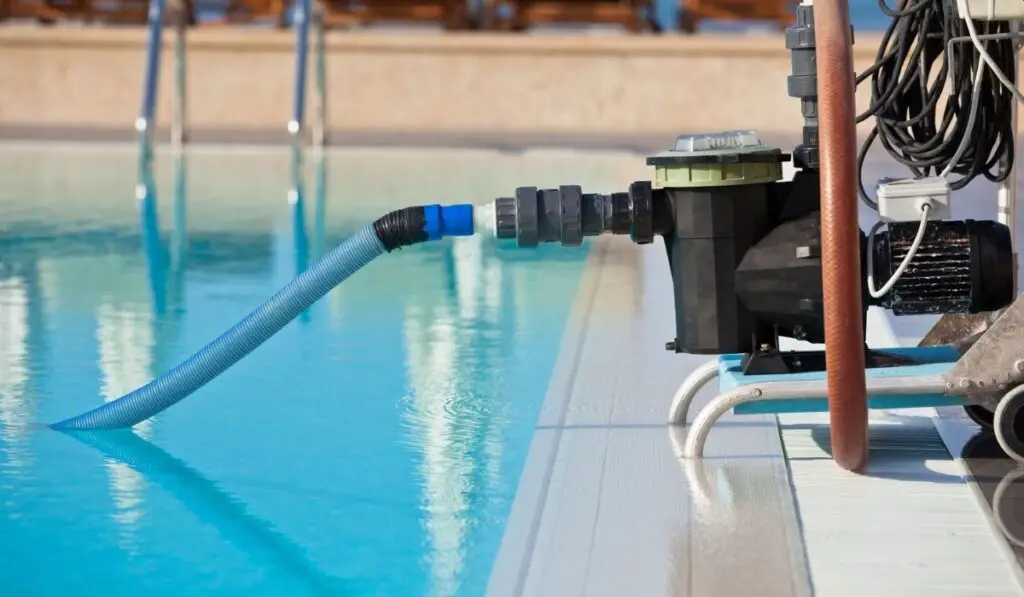Backwashing is the process of reversing the flow of water through your pool filter to clean it. When you backwash, dirty water is flushed out through the waste line, and freshwater is drawn in through the skimmer. Backwashing helps to remove dirt and debris that has accumulated in the filter over time. So how often should the pool be backwashed?
How often to backwash depends on the type of filter you have and how quickly dirt/debris accumulates. Your pool should generally be backwashed once a week, or when the pressure starts to fall on the pump outlet (when you notice lower flow). High pollen or dirt events may require extra backwashing.
Keeping the pool clean and free of debris is important for the longevity of your pool and the health of swimmers. By backwashing your pool regularly, you can help prolong the life of your pool filter and keep your pool looking its best. Let’s take a look at how exactly to backwash your pool and when to do so.
What Does Backwashing a Pool Mean?

Backwashing a pool means reversing the flow of water through your pool filter to clean it. Have a look at this typical Intex sand/pump filter (on Amazon). In a unit like this, the handle on top is used to route water backward through the sand filter, pushing all the dirt trapped in it out to the drain.
Most pools remove organic debris by pushing water through a porous medium such as sand and returning clean water to the pool. Over time, however, larger particles can accumulate and clog the filter, reducing its effectiveness.
Backwashing removes trapped waste and pollutants, forcing them out through the waste line or a hose linked to the pool pump. This lowers the water pressure and allows the pump to run more efficiently.
How to Backwash Your Pool
You should backwash the pool at least once a week or when the pressure rises 8-10 PSI above the starting pressure. If your pool is utilized frequently or if there’s a lot of debris in the water for whatever reason, it may need to be done more often.
Failing to backwash the pool often enough can lead to clogging, which reduces the filter’s efficiency and promotes the growth of algae.
To backwash your pool:
- Turn off the pool pump and release any pressure in the system by opening the air relief valve.
- Set your filter to the “backwash” mode and start the pump.
- Run the pump for 3-5 minutes, or until the water coming out of the waste line is clear.
- Shut off the pump and close the air relief valve.
- Set the filter to “rinse” mode and run the pump for one minute to clear out any debris that may have been dislodged during the backwashing process.
- Shut off the pump and set the filter to “run” mode.
- Open any valves that were closed during the backwashing process and turn on the pool pump.
The process takes about 10 minutes and is a relatively easy task to perform.
How to Shock Your Pool
Pool shock (on Amazon) is a chemical used to kill bacteria, algae, and other contaminants in your pool. It is also used to quickly raise the chlorine level to achieve what is called “breakpoint chlorination.” This is the point at which the chlorine level is high enough to kill all of the contaminants in the water.
Shocking the pool should be done regularly, typically once a week or after heavy rain or pool use. The frequency may be increased if the pool is utilized frequently or if there are a lot of swimmers using it.
Shocking the pool too often can lead to skin and eye irritation, so it is important to follow the manufacturer’s instructions carefully.
To shock your pool:
- Turn off the pool pump and add the recommended amount of pool shock to the water.
- Turn on the pool pump and circulate the water for at least one hour.
- Test the chlorine level and make sure it’s between 1-3 ppm.
- If the chlorine level isn’t within the desired range, add more pool shock and circulate for another hour.
- Once the chlorine levels are where they should be, turn off the pool pump and allow the water to settle for at least 30 minutes before swimming.
Shocking the pool regularly is important to maintain water quality and prevent the growth of bacteria and algae. While it is a relatively simple process, carefully following the manufacturer’s instructions is vital to avoiding skin and eye irritation.
Should You Backwash Your Pool After Shocking?
It isn’t necessary to backwash the pool immediately after shocking it. In fact, it is best to wait at least eight hours before backwashing to give the pool shock time to work.
Shocking the pool will raise the chlorine levels quickly, killing bacteria and algae. However, if the chlorine levels are too high, it can irritate your skin and eyes. Backwashing the pool will spread the chlorine and lower the levels to a safe range.
The pressure gauge reading is one method to help you determine if you need to perform this operation. As soon as the pool filter is turned on, take note of the pressure gauge reading. Then recheck it after some time. If the readings rise by eight or more units, it’s recommended that you backwash the pool.
Swimming After Shocking Your Pool

You can swim in your pool as soon as the chlorine levels have returned to normal after shocking the pool. It is important to test the chlorine levels before swimming to ensure they aren’t too high.
Chlorine levels that are too high can irritate your skin and eyes, while low levels may be ineffective against bacteria and algae, resulting in health problems for swimmers.
To be safe, wait at least eight hours after shocking your pool before swimming in it. Once the chlorine levels have returned to normal, you can enjoy your pool.
